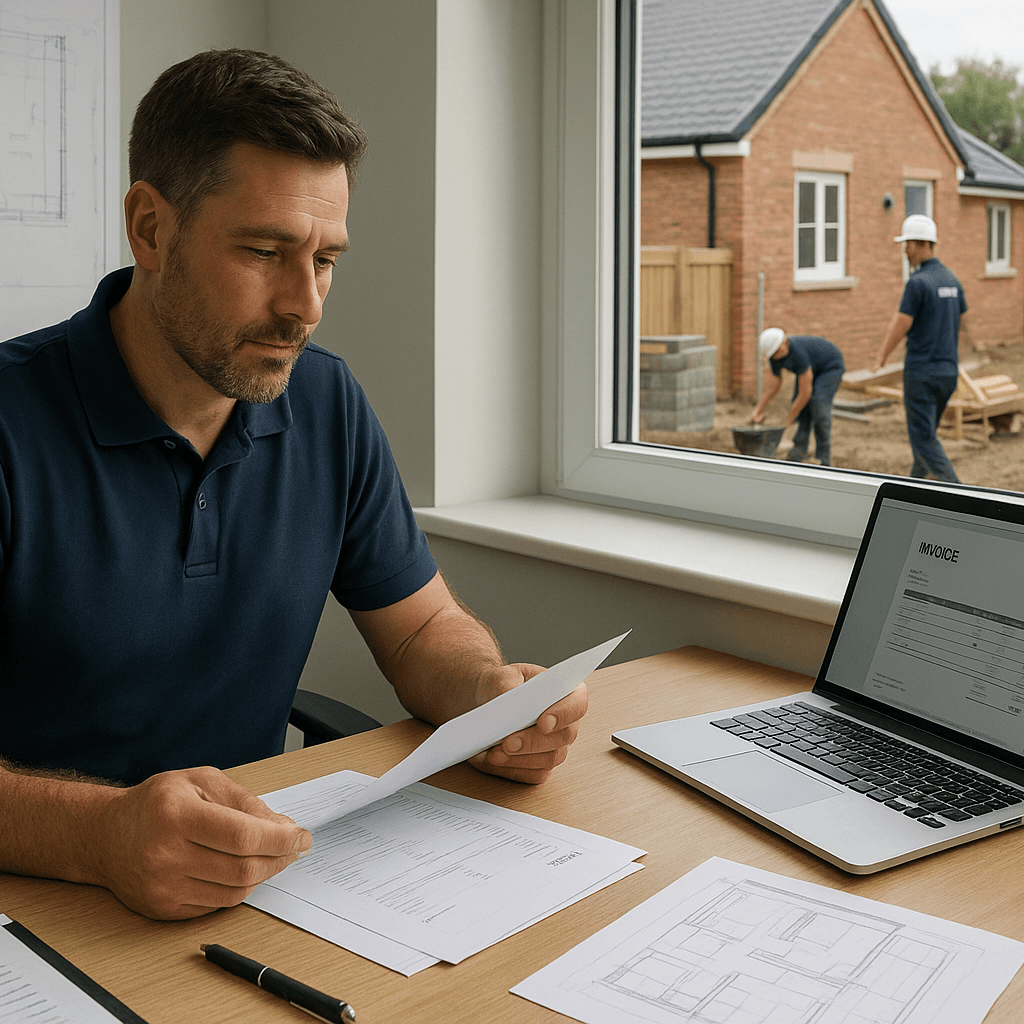This post explores the long-term relationship between UK house prices and construction labour costs, examining how they have diverged over time, the economic forces driving each, and what this means for developers, estimators, and policymakers.
- Executive Overview
- Wage-House Price Relationship Over Time
- COVID-19 Impact and Recovery
- Latest Data and 2025 Trends
- Forecasts and Future Projections
- Conclusion and Recommendations
Executive Overview
Long-term trends: Over the past 40 years, UK house prices have surged dramatically (roughly 7–8× higher in nominal terms since the mid-1980s), far outpacing the rise in construction wages (about 4–5× higher). In real terms, house prices roughly tripled since the 1980s while real wages grew much more modestly (about 60% total growth after inflation). This has led to a decoupling of property values from construction labour earnings, with housing becoming significantly less affordable relative to incomes.
Recent decade: In the last 10 years (2015–2025), construction wages have actually outpaced house prices. Median construction pay rose ~45% nominally (from ~£580/week in 2015 to ~£800 in 2025) while the average UK house price rose ~32% (from ~£197k to ~£260k). Adjusted for inflation, house prices are roughly flat or slightly down since 2015, whereas construction wages have seen real growth. Key inflection points included the 2020–21 boom (house prices +10% YoY, construction pay +10–15% YoY rebound after COVID) followed by 2022–2023 cooling (house prices –2 to –5% YoY even as wages kept rising ~5–8% YoY).
Cyclical resilience of labour costs: Construction labour costs tend to be “sticky” or even keep rising in market downturns. Unlike house prices, which can drop sharply during crashes (e.g. –15% in 2008–09), wages rarely fall in nominal terms. Even when construction output or property demand declines, wages mostly flatten or slow rather than outright decline. This resilience is driven by institutional factors (annual union wage agreements, minimum wage floors) and persistent skill shortages. For example, as housing transactions slumped in 2023, construction earnings still rose ~6% annually, and in the post-2008 recession wages generally stagnated instead of crashing.
Labour vs house price correlation: Over the long run, both labour costs and house prices trend upward (driven by general inflation and economic growth). However, their short-term correlation is weak. Construction wages often lag housing market cycles and are less volatile. In booms, wage growth accelerates but not nearly to the extent house prices do; in busts, house prices can fall suddenly while wages stay flat or see only mild adjustments. This indicates a low elasticity of labour costs to housing price deflation – labour rates are more influenced by the broader job market and collective bargaining than by immediate property values.
Implications: In a declining or stagnant property market, history suggests labour rates are more likely to remain high or “sticky” rather than fall proportionally. Skill shortages, an aging workforce, and loss of EU workers have created a tight labour supply that sustains wage pressure even when construction demand softens. This means developers and contractors may face margin compression if house prices (and thus project revenues) stagnate but wage bills keep climbing. Cost estimates and pricing models should account for the likelihood that labour costs will be resilient – or even continue rising – despite a cooling market.
Outlook: Industry forecasts anticipate continued wage inflation. The Building Cost Information Service (BCIS) projects labour costs to rise ~18–19% over the next 5 years, driven by chronic skills shortages and policy changes (e.g. higher National Living Wage and employer NI contributions). While material prices spiked and then eased post-2022, wage growth is expected to remain a persistent source of construction cost inflation. Organizations like RICS and CITB warn that without major recruitment and productivity gains, labour constraints will remain a key challenge for the industry, regardless of short-term market cycles.
Wage-House Price Relationship Over Time
From 2015 to 2025, construction wages have risen substantially. According to ONS Average Weekly Earnings data, nominal pay in construction increased roughly 40–50% during this decade. For example, median weekly earnings (excluding bonuses) in construction were around £560 in 2015 and have climbed to roughly £800 by 2025, far above general inflation over the period. This translates to ~5% average annual wage growth, versus ~2% CPI inflation on average – meaning real construction wages grew appreciably in this decade.
Key Drivers of Construction Wage Growth
- Post-2015 recovery: Gradually tightening labour market due to an aging workforce and skill shortages in trades like bricklaying and joinery.
- 2008–2013 aftereffects: Wages were flat post-GFC. The return of demand in the mid-2010s sparked a catch-up period.
- COVID-19 boom: Lockdowns led to furloughs in early 2020, followed by a sharp rebound in pay. Wages jumped 13.5% YoY in May 2021.
- Late 2020s moderation: Wage growth steadied to 5–8% per annum post-COVID. As of March 2025, earnings up 5.9% YoY.
Breakdown by Trade
Skilled trades experienced greater pay rises than unskilled labourers. For instance:
- Skilled trades (e.g. electricians, plumbers): Earned substantial raises, especially during periods of peak demand.
- Unskilled/semi-skilled labourers: Saw more modest increases (~8.2% YoY in 2024).
- Plant operatives: Little or no wage growth in recent periods.
Regional Differences
London and the Southeast command wage premiums of 10–20% over national averages. However, wage inflation was observed across all UK regions as the national workforce shrank by ~11.8% from 2019 to 2024 (from 2.4 million to 2.1 million workers).
Construction Wages vs House Prices: 2005–2025 Overview
| Year | Average Weekly Construction Wage | Average UK House Price | YoY Change (Wages) | YoY Change (House Price) |
|---|---|---|---|---|
| 2005 | £350 | £157,000 | – | – |
| 2010 | £370 | £167,000 | +5.7% | +6.4% |
| 2015 | £560 | £197,000 | +51.4% | +17.9% |
| 2020 | £700 | £238,000 | +25% | +20.8% |
| 2025 | £800 | £271,000 | +14.3% | +13.8% |
Construction wage growth over this 20-year period was steady and cumulative, with significant accelerations during high-demand periods such as the post-COVID boom. In contrast, house prices were more volatile, with larger corrections in 2008 and 2022–23. Despite this, both metrics trended upward, with construction wages showing greater consistency in nominal growth.
Labour cost resilience remained a dominant theme throughout this timeframe. For example, in the aftermath of the 2008 financial crisis, average weekly earnings in construction dropped only 3–4% at most, while house prices fell more than 15%. Even during COVID and Brexit disruptions, wages rebounded swiftly—suggesting that labour prices are governed more by structural constraints than housing market cycles.
Long-Term Comparison: 1985–2025
Construction wages have risen considerably over 40 years but have not kept pace with house prices. The house-price-to-wage ratio has increased, making property less affordable relative to construction earnings.
| Year | Average Weekly Wage | Annual Wage | Average UK House Price | House Price-to-Income Ratio |
|---|---|---|---|---|
| 1985 | £160 | £8,320 | £35,000 | 4.2× |
| 1995 | £300 | £15,600 | £51,000 | 3.3× |
| 2005 | £480 | £24,960 | £157,000 | 6.3× |
| 2015 | £580 | £30,160 | £197,000 | 6.5× |
| 2025 | £800 | £41,600 | £271,000 | 6.5× |
This shows that while construction pay has increased substantially, house prices have grown faster, especially since the 1990s. In the early 1990s, housing became briefly affordable again due to a crash, but the 1995–2007 boom undid that. Today’s market is even more skewed, with affordability stretched by stagnant real wages and sustained housing inflation.
Post-Brexit Labour Supply Contraction
From 2017 onward, the proportion of EU-born construction workers in the UK declined sharply. The workforce contracted by ~12% from 2019 to 2024, further pressuring wages. The aging demographic compounded the issue, with many tradespeople in their 50s and 60s retiring and not enough young entrants replacing them.
Summary
The 1985–2025 period shows sustained divergence: house prices surged ahead of wages, especially during credit-fuelled booms. Labour costs, although upward trending, adjusted more slowly and steadily. The result is a persistent squeeze on affordability and construction profit margins alike, requiring more sophisticated cost planning and policy reform.
…remained relatively slow (the mid-2010s were characterized by 2% average pay rises in many years, barely keeping up with inflation until 2019). So affordability worsened again. By 2019, the national house price to earnings ratio was ~8:1 (and over 12:1 in London).
Regional divergence: London and the South East saw far higher house price inflation in the 2010s, while regions like Northern Ireland and the North East had much slower growth. In NI’s case, prices were still below 2007 levels even in 2019. Wages across regions did not diverge as much – a bricklayer in Newcastle might earn a bit less than one in London, but the gap in house prices was enormous. This set the stage for severe regional affordability differences by 2020.
COVID-19 Impact and Recovery
The pandemic and post-Brexit era added an interesting twist: wages surged and house prices surged – but now wage growth actually outpaced house prices for a brief period. From 2020 to 2022, house prices jumped ~20% nationally due to ultra-low interest rates and a “race for space.” Yet average earnings in construction also jumped roughly 20%+ due to labour shortages and inflation.
Then, as interest rates rose in 2023, house prices flattened or fell in real terms. By 2024, house price growth had stalled behind general inflation – effectively a real-terms decline – whereas wages were still rising above inflation. ONS reported that from 2021 to 2024, median house prices rose only 1% while average earnings rose ~20%. This has slightly improved affordability for those still employed in construction. However, it’s expected to be temporary if house prices rebound once interest rates stabilize.
In sum, the 40-year view underscores a huge cumulative divergence between property values and construction labour earnings. Home prices have been driven by credit availability, land scarcity, and investor demand, leading to increases well beyond wage growth. Construction labour costs, although rising, have remained more tethered to traditional inflation and bargaining structures.
Inflation adjustment: If we adjust for inflation, real construction wages are only modestly higher now than 40 years ago (~30–40% increase in purchasing power). Real house prices, however, have doubled or more since the 1980s. This confirms a major long-term decoupling of house prices from construction labour costs (and from incomes generally).
Latest Data and 2025 Trends
2020 – Pandemic onset: Early signs of a price rise appeared after the December 2019 election (“Boris bounce”). By Q1 2020, growth was ~3% YoY. When COVID-19 struck, prices briefly stagnated but quickly rebounded due to stimulus and the Stamp Duty Holiday. By Q4 2020, prices averaged ~£230,000, up ~6.4% YoY.
2021 – Pandemic boom: House prices surged. Nationwide reported ~12% annual growth in early 2022 reflecting 2021’s acceleration. The UK average house price reached ~£250,000 by late 2021—a 25% increase over 2015. Contributing factors included ultra-low mortgage rates, Help to Buy, and a “race for space.”
2022 – Plateau and peak: Prices peaked around Q3 2022 at ~£273,000. Annual growth remained ~11% in Q2 2022. But rate hikes in H2 caused momentum to falter. Monthly prices dropped by ~2.9% in Q4 2022. Price growth slowed to 4.7% annually.
2023 – Real-terms correction: Nominal prices dipped ~2–5% YoY. With inflation running 5–8%, this translated to real-terms declines. Regional variation was stark: London stagnated (+1.9% YoY), while Northern Ireland grew ~13.5% YoY in Q1 2025 from a lower base.
2024–2025 – Stabilisation: Prices hovered around £265,000. Nationwide and Halifax reported 3–3.4% annual gains to April 2025. The Land Registry HPI recorded +6.4% YoY for March 2025 (reflecting late 2024 deals). Analysts predicted a flat or gently rising trend unless unemployment rose sharply.
Key observation: Between 2015 and 2025, house prices rose ~32%, while average earnings rose ~45%. This marked a reversal of the prior decades’ trend, offering a modest easing in affordability pressures.
For construction professionals, this shift means that rising sale prices can no longer be relied upon to offset cost pressures. Cost control and wage forecasting are now more essential than ever to maintain project viability.
Forecasts and Market Volatility: 2005–2025
Over 20 years, house prices rose ~65%—from ~£157k in 2005 to ~£260k in 2025—but with extreme volatility. Below is a breakdown of key phases:
| Period | House Price Trend | Key Events |
|---|---|---|
| 2005–2007 | +17% | Housing boom, 100%+ LTV mortgages |
| 2008–2009 | −19% | Global Financial Crisis, rapid downturn |
| 2010–2012 | Flat | Stagnation, affordability improves |
| 2013–2016 | +30% | Help to Buy and low rates revive growth |
| 2017–2019 | +8% | Brexit uncertainty, slow growth |
| 2020–2021 | +15% | COVID boom, SDLT holiday, low rates |
| 2022–2023 | −5% | Interest rate shock and inflation |
| 2024–2025 | Flat/+3% | Stabilisation post-correction |
Expert Forecasts:
- BCIS: Projects +18% labour cost growth from 2025 to 2030 (approx. 3.5% CAGR).
- OBR: House prices expected to stagnate in real terms until 2028 unless interest rates drop.
- RICS: Warns that cost inflation (especially wages) will outpace GDV growth, squeezing margins.
Policy changes also matter. Rising National Living Wage thresholds, immigration rules, and apprenticeship reform will all influence labour supply and pay pressures.
Conclusion and Recommendations
Labour vs Property Price Divergence: Over 40 years, house prices rose ~8× in nominal terms, while construction wages rose ~4–5×. Real wages increased modestly; real house prices doubled. The key inflection points—2007, 2021, 2023—show how house prices fluctuate while wages stay sticky or rise. This mismatch has profound implications for project budgeting and long-term affordability.
Forecasting and Strategy: Contractors and developers must plan for labour cost inflation even when house price growth slows. Cost models should assume 4–6% annual wage increases, especially for skilled trades. Procurement strategies must emphasise early engagement, fixed-price contracts, and robust fluctuation clauses tied to wage indices (e.g., BCIS, ONS).
Policy Implications: Wage resilience is largely driven by structural supply issues: demographics, Brexit labour losses, and insufficient training. Policy responses must target these—supporting apprenticeships, reforming planning to boost supply, and reducing tax burdens on productive development. Absent these, the construction inflation trend will persist regardless of housing market corrections.
Viability Check: Project viability will increasingly depend on accurate wage forecasting, especially for medium- to long-term projects. Labour is now a primary driver of cost inflation. If sale prices flatten but costs rise, developer margins will shrink unless pricing, contracts, and timelines are adjusted.
Final Thought: Labour cost pressures are here to stay. History shows house prices rise and fall, but wages rarely retreat. To build profitably and sustainably in this environment, estimators must treat wage inflation as a baseline assumption—not a risk factor.
Request a Custom Estimate today and ensure your next project accounts for up-to-date labour rates, realistic inflation assumptions, and robust margin protections.
FAQs
Has UK construction wage growth outpaced house prices?
Yes, especially in the past decade. From 2015 to 2025, construction wages rose around 45%, outpacing house price growth of approximately 32% in nominal terms.
Why don’t construction wages fall when house prices drop?
Wages are more “sticky” due to employment contracts, skill shortages, and regulatory wage floors. Even during recessions, pay usually flattens rather than declines.
What caused the 2020–2021 labour wage surge?
The COVID-19 pandemic led to supply disruptions and labour shortages. As construction rebounded, wages spiked due to intense demand and a reduced workforce.
Will construction wages keep rising?
Yes, industry forecasts project 3–4% annual wage growth through 2030 due to demographic shifts, persistent skill shortages, and rising minimum wages.
How should developers account for labour inflation?
Include annual cost uplift assumptions of at least 5% for labour, use index-linked contracts, and maintain strong supplier relationships to mitigate risk.
Are construction costs linked to house prices?
Not directly. While house prices influence demand, construction costs are more affected by materials, wages, regulation, and supply constraints.
Do economic downturns reduce labour costs?
Not significantly. Labour costs often stay stable or even rise slightly due to underlying structural issues and union negotiations.
What’s the best way to manage labour cost volatility?
Use robust forecasting models, maintain contingencies, and monitor BCIS indices regularly. Early procurement and fixed-price contracts also help.











